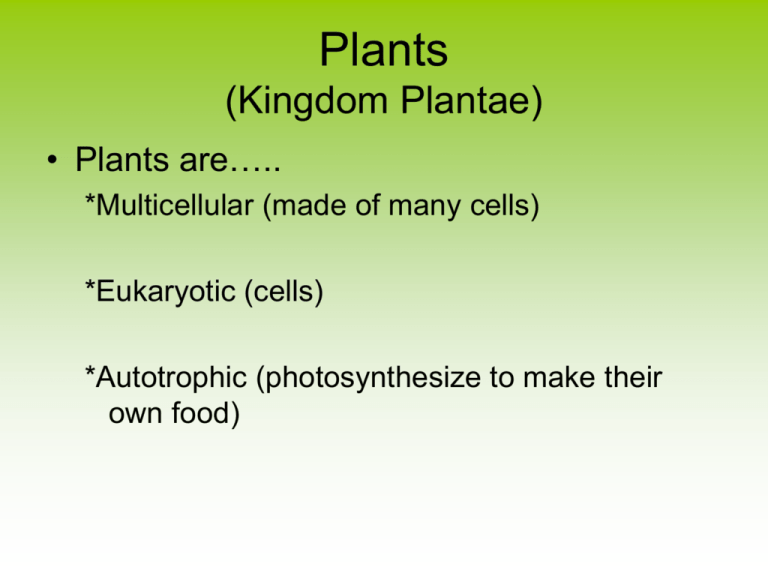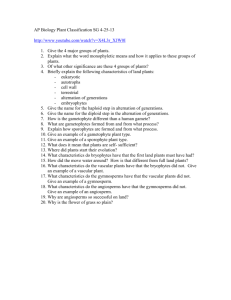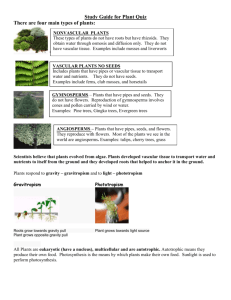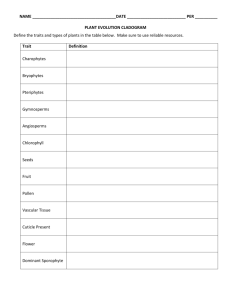Plant Cells
advertisement

Plants (Kingdom Plantae) • Plants are….. *Multicellular (made of many cells) *Eukaryotic (cells) *Autotrophic (photosynthesize to make their own food) Plants (Kingdom Plantae) Animal Cells vs. Plant Cells Plants (Kingdom Plantae) Non-vascular Plants Low growing plants, found in moist, shaded areas where water is in regular supply • Include “groundcover” plants, like moss • Lack vascular tissue (xylem and phloem). Draw up water by osmosis and transfer it by cell to cell contact • Needs water for reproduction • Can live in many different environments from polar regions to the tropics Vascular Plants Seedless and seed plants with vascular tissue that can grow to great heights in any environment • Includes ferns, gymnosperms and angiosperms • Have vascular tissues to transport water and nutrients around the plant against gravity • Can reproduce without water by pollination and seeds • Very diverse group of plants • Populate most of the earth Plants (Kingdom Plantae) Non-vascular Plants Vascular Plants Plants (Kingdom Plantae) Gymnosperms Angiosperms Plants (Kingdom Plantae) Gymnosperms vs. Angiosperms Comparing Features of Seed Plants Feature Gymnosperms Angiosperms Seeds Bear their seeds on cones Bear their seeds within flowers Reproduction Can reproduce without water; male gametophytes are contained in pollen grains; fertilization occurs by pollination Can reproduce without water; male gametophytes are contained in pollen grains; fertilization occurs by pollination Examples Conifers, cycads, ginkgoes, gnetophytes Grasses, flowering trees and shrubs, wildflowers, cultivated flowers The 5 Main Parts of a Plant Buck Wheat Roots: Two Types Tap Root Fibrous Root Root Structure Root Structure Root Functions • • • • Anchor the plant Absorb water and dissolved nutrients Prevent erosion of the soil around it Prevent disease Stems- Major functions • Connects roots to leaves • Transports water and dissolved nutrients (minerals) to all parts of the plant • Transports food (glucose) around the plant • Allows plants to grow vertically (Hold leaves up to the sunlight) • Produces leaves, branches and flowers Types of Stems Monocot Dicot Stems- 2 Types of Growth • Primary Growth Apical meristems located at the tips of shoots and roots produce primary growth. The tissues that result from primary growth are known as primary tissues. • Secondary Growth Secondary growth increases a plant’s stem and root width. In woody stems, secondary growth is produced by the cork cambium and vascular cambium, two meristems near the outside of the stem. The Vascular Plant Body Vascular Tissues •Vascular Tissues Vascular tissue conducts water, minerals, and organic compounds throughout the plant. •Xylem Xylem contains vessels, which are made up of cells that conduct water only after they lose their cytoplasm. Water flows between cells through pits and perforations in their cell walls. •Phloem Phloem contains sieve tubes, which are made up of cells that are still living. Substances pass between the cells through pores. Leaf functions • Photosynthesis: Structure is optimized for absorbing light and carrying out photosynthesis • Transpiration: Loss of water through the leaves. Important for photosynthesis. Lost water is replaced by water drawn in by xylem vessels in the vascular tissue. • Gas Exchange: Leaves take in CO2 and give off O2 during photosynthesis. – Done by stomata (small pores) regulated by guard cells. – Guard cells allow photosynthesis to take place without losing excess water. The Leaf - Structure Cuticle Veins Epidermis Palisade mesophyll Phloem Vein Xylem Spongy mesophyll Epidermis Stoma Guard cells Transport in Plants Movement of Water •Transpiration: Transpiration, the loss of water from a plant’s leaves, creates a pull that draws water up through xylem from roots to leaves. •Guard Cells and Transpiration: Guard cells control water loss by closing a plant’s stomata when water is scarce. Thus, they also regulate the rate of transpiration. Structure of Guard Cells Guard cells Guard cells Inner cell wall Inner cell wall Stoma Stoma Open Stoma Closed The Structure of a Flower Stamen Anther Filament Ovule Stigma Style Carpel Ovary Petal Sepal Comparing Wind-pollinated and Animal-pollinated Plants Characteristics Wind-pollinated Plants Animal-pollinated Plants Pollination method Wind pollination Vector pollination Relative efficiency of pollination method Less efficient More efficient Plant types Mostly gymnosperms and Angiosperms some angiosperms Reproductive organs Cones Flowers Adaptations that promote pollination Pollination drop Bright colors, sweet nectar Fruit Simple, Aggregate, Multiple and Dry • Simple Fruits: These fruit types are produced by flowers containing one pistil, the main female reproductive organ of a flower. • Aggregate Fruits: These fruits types are developed from flowers which have more than one pistils. They consist of mass of small drupes that develops from a separate ovary of a single flower. • Multiple Fruits: These fruit types are developed not from one single flower but by a cluster of flowers. • Dry Fruits: These fruit types are developed from plant parts other than the ovary. Fruit Simple, Aggregate, Multiple and Dry • Simple Fruits: Grapes, tomatoes, avocados, limes, cucumbers, apples, pumpkin, coconut, olive, pear • Aggregate Fruits: Strawberry, blackberry, raspberry, boysenberry, loganberry, cloudberry, wineberry • Multiple Fruits: Pineapple, pomegranate, kiwi, passion fruit • Dry Fruits: Sweet pea, beans, peanut, wheat, oats, rice, corn, walnut, hazelnut, chestnut, acorn Comparison of Monocot to Dicot plant parts Monocots Dicots Seeds Single cotyledon Two cotyledons Leaves Parallel veins Branched veins Flowers Floral parts often in multiples of 3 Floral parts often in multiples of 4 or 5 Stems Vascular bundles scattered throughout stem Vascular bundles arranged in a ring Roots Fibrous roots Taproot Tropisms: the response of plants to external stimuli •Controlled by hormones called “auxins” •Control plant growth and development •Control plant response to environment •Stimulate cell elongation Photoperiodism and Flowering Responsible for the timing of seasonal activities such as flowering and growth. Short-Day Plant Midnight Noon Long Day Midnight Noon Short Day Midnight Noon Interrupted Night Long-Day Plant





